
This is the best kept winter mountaineering secret in Baxter State Park
By Ron Chase
Most skiers, ice climbers and mountaineers focus on Chimney Pond with their sights set squarely on Mount Katahdin in Baxter State Park.
Many peak baggers trek into the hut at Nesowadnehunk Field to access the four high mountains located in the northwestern sector of the park.
Perhaps the best kept winter mountaineering secret in Baxter State Park is South Branch Pond.
Located in the northeastern part of the park, the South Branch Pond region is a unique experience. The two connected ponds, Upper and Lower South Branch Ponds, are bordered by mountains on the east and west and have the character of an inland fjord.

SKI APPROACH — Skiers approach Horse Head Mountain in Baxter State Park.
The campground at the pond features a roomy cabin with a woodstove, gas lamps and eight bunks. That was our destination for a late winter expedition.
I was part of a group of eight skiers and mountaineers who trekked to South Branch Pond on a multi-day excursion last winter. While a successful outing, heavy snow accumulations and stormy, windy weather prevented us from achieving two significant goals: completion of the famed Traveler Loop and a hike over South Branch and Black Cat Mountains.
Those objectives were on our minds when eight of us obtained early March South Branch hut reservations last Nov. 1.
In the four-month interim, medical issues affected the makeup of the group. Two members of the team had to bow out due to serious health issues, while another couldn’t leave ailing family members.
In December, I was diagnosed with arthritis in my left knee and began cortisone treatments. Easily the senior citizen in the now six-person assemblage, it was unclear how much mountaineering I could do. Based on earlier winter experiences, skiing was a better option.

HUT — The hut at South Branch Pond was the group destination at Baxter State Park.
Obviously, no one can predict the weather when reservations are obtained four months in advance. History told us snowfall through the winter would result in hefty accumulations by early March.
Not this year.
The park, and much of Maine, received record low snow amounts and unusually heavy rainfall. Whether there would be adequate snow to ski into the pond was a concern.
Calls to the area confirmed there was still acceptable but diminishing levels of snow on park roads. But a warm rainy weather forecast did not bode well for our six-day adventure.
Several of us stayed in a cabin at Matagamon Campground just outside of the park the night before the excursion began. In deference to my arthritic knee, most of us hired the campground to shuttle our gear by snowmobile on the park Perimeter Road as far as the beginning of South Branch Pond Road.
Park rules prohibit snowmobiles on South Branch Pond Road so our plan was to haul gear on sleds for the remaining 2.2 miles.
Six enthusiastic skiers met at the Matagamon Winter Trailhead on a warm foggy morning. Light rain had fallen the night before, leaving a soft ice and wet snow base for skiing. After the snowmobile and trailer departed with our sleds and gear, we began the 11 mile journey to South Branch Pond Road.
The skiing was surprisingly good and we completed the cruise in about 2.5 hours. While we were assembling our sleds for the haul to the pond, two Park Rangers arrived on snowmobiles. They were headed to South Branch to check ice safety and promised an update when they returned.
Some of us hauled heavy sleds while wearing micro spikes while others continued with skis.
Much of the trek was uphill before leveling off and then descending to the pond. When the rangers stopped, they advised against skiing or snowshoeing on the pond because it was heavily puddled and thin in places.
That eliminated the possibility of a coveted ski south on the winter Pogy Trail. Mountaineering would be our focus.
We completed the arduous sled pull in a little more than an hour and settled into the bunkhouse. Cabin chores were next. Firewood was brought in from the woodshed and a fire started in the woodstove.
Others retrieved water from an open section at the outlet of the pond. All water has to be purified.
During a delicious dinner, we established a game plan for the following day. We would be up early and attempt a climb of North Traveler Mountain, possibly continuing on the Traveler Loop.
My book, “Maine Al Fresco: The Fifty Finest Outdoor Adventures in Maine” narrates several winter mountaineering and ski expeditions.